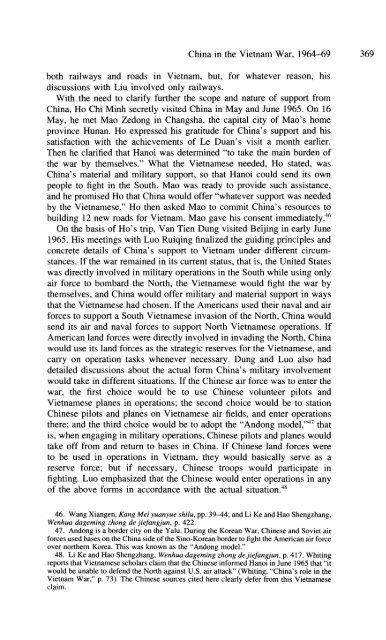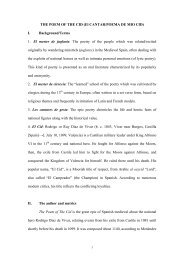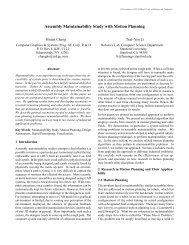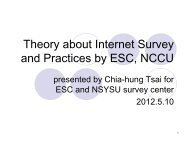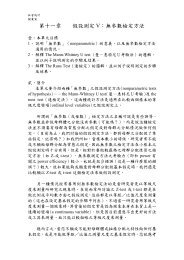368 The Ch<strong>in</strong>a Quarterlysecretly visited Beij<strong>in</strong>g.43 On 8 April, Liu Shaoqi, on behalf of <strong>the</strong> CCPCentral Committee, met Duan and Giap. Duan, accord<strong>in</strong>g to <strong>the</strong> Ch<strong>in</strong>eserecord, told his hosts at <strong>the</strong> beg<strong>in</strong>n<strong>in</strong>g of <strong>the</strong> meet<strong>in</strong>g that <strong>the</strong> <strong>Vietnam</strong>ese"always believed that Ch<strong>in</strong>a was <strong>Vietnam</strong>'s most reliable friend," andthat "<strong>the</strong> aid from Ch<strong>in</strong>a to <strong>Vietnam</strong> was <strong>the</strong> most <strong>in</strong> quantity, as well as<strong>the</strong> best <strong>in</strong> quality." Liu thanked Duan and told him that "it was <strong>the</strong>consistent policy of <strong>the</strong> Ch<strong>in</strong>ese Party that Ch<strong>in</strong>a would do its best tosatisfy whatever was needed by <strong>the</strong> <strong>Vietnam</strong>ese." Duan <strong>the</strong>n stated that<strong>the</strong> <strong>Vietnam</strong>ese hoped Ch<strong>in</strong>a would send volunteer pilots, volunteertroops and o<strong>the</strong>r volunteers - such as eng<strong>in</strong>eer<strong>in</strong>g units for construct<strong>in</strong>grailways, roads and bridges - to North <strong>Vietnam</strong>. He emphasized that <strong>the</strong>dispatch of <strong>the</strong>se forces would allow Hanoi to send its own troops to <strong>the</strong>South. Duan fur<strong>the</strong>r expressed <strong>the</strong> hope that <strong>the</strong> support from Ch<strong>in</strong>awould achieve four ma<strong>in</strong> goals: restrict American bombardment to areassouth of ei<strong>the</strong>r <strong>the</strong> 20th or <strong>the</strong> 19th parallels; defend Hanoi and areasnorth of it from American air bombardment; defend North <strong>Vietnam</strong>'sma<strong>in</strong> transportation l<strong>in</strong>es; and raise <strong>the</strong> morale of <strong>the</strong> <strong>Vietnam</strong>ese people.Follow<strong>in</strong>g Mao's <strong>in</strong>structions, Liu agreed to most of Duan's requests. Hetold Duan that <strong>the</strong> CCP had made <strong>the</strong> decision that "it is our policy thatwe will do our best to support you. We will offer whatever you are <strong>in</strong>need of and we are <strong>in</strong> a position to offer." Liu also stressed that "if youdo not <strong>in</strong>vite us, we will not come; and if you <strong>in</strong>vite one unit of ourtroops, we will send that unit to you. The <strong>in</strong>itiative will be completely atyour disposal.""44In spite of <strong>the</strong>se promises, <strong>the</strong>re are clues that divergences existedbetween <strong>the</strong> two sides. First, although Duan asked for <strong>the</strong> dispatch of <strong>the</strong>Ch<strong>in</strong>ese air force (<strong>in</strong> <strong>the</strong> form of volunteer pilots) to <strong>Vietnam</strong>, <strong>the</strong>Ch<strong>in</strong>ese were reluctant to do this, at least at this stage.45 Secondly, Duan<strong>in</strong>vited <strong>the</strong> Ch<strong>in</strong>ese to play a role <strong>in</strong> defend<strong>in</strong>g <strong>Vietnam</strong>'s transportationsystem and important targets <strong>in</strong> areas up to <strong>the</strong> 19th parallel, whereas <strong>the</strong>Ch<strong>in</strong>ese, as was made clear later, would <strong>in</strong> most circumstances not let<strong>the</strong>ir anti-aircraft troops go beyond <strong>the</strong> 21st parallel. Thirdly, Duanrequested <strong>Ch<strong>in</strong>a's</strong> assistance <strong>in</strong> construct<strong>in</strong>g, ma<strong>in</strong>ta<strong>in</strong><strong>in</strong>g and defend<strong>in</strong>g43. It seems that <strong>the</strong> visit was divided <strong>in</strong>to two parts. In early April, Le Duan and VoNguyen Giap arrived <strong>in</strong> Beij<strong>in</strong>g secretly, and met Liu Shaoqi and o<strong>the</strong>r Ch<strong>in</strong>ese leaders on8 April. The <strong>Vietnam</strong>ese delegation <strong>the</strong>n travelled to Moscow on 10 or 11 April, and stayed<strong>the</strong>re until 17 April to hold a series of talks with Soviet leaders. They <strong>the</strong>n came back to Beij<strong>in</strong>gon 18 April to cont<strong>in</strong>ue <strong>the</strong>ir visit to Ch<strong>in</strong>a <strong>in</strong> an open manner. For a summary of <strong>the</strong>delegation's visit to <strong>the</strong> Soviet Union and <strong>the</strong> second half of its visit to Ch<strong>in</strong>a, see Smith, AnInternational History of <strong>the</strong> <strong>Vietnam</strong> <strong>War</strong>, Vol. 3, pp. 92-97.44. Li Ke and Hao Shengzhang, Wenhua dagem<strong>in</strong>g zhong de jiefangjun, p . 415; WangXiangen, Kang Mei yuanyue shilu, p. 44; Han Huaizhi et al., Dangdai Zhongguo jundui dejunshi gongzuo (The Military Affairs of <strong>the</strong> Contemporary Ch<strong>in</strong>ese Army) (Beij<strong>in</strong>g: Ch<strong>in</strong>eseSocial Sciences Press, 1989), Vol. 1, pp. 539-540; Shi Y<strong>in</strong>gfu, Mimi chub<strong>in</strong>g yare congl<strong>in</strong>(Send<strong>in</strong>g Troops Secretly to <strong>the</strong> Sub-tropical Jungles) (Beij<strong>in</strong>g: People's Liberation ArmyLiterature Press, 1990), pp. 14-16.45. In <strong>the</strong> spr<strong>in</strong>g and summer of 1965, <strong>the</strong> Beij<strong>in</strong>g leadership ordered Ch<strong>in</strong>ese air units thathad entered <strong>the</strong> Ch<strong>in</strong>ese-<strong>Vietnam</strong>ese border area not to cross <strong>the</strong> border under anycircumstances. See Liu Yuti and Jiao Hongguang, "Operations aga<strong>in</strong>st <strong>in</strong>vad<strong>in</strong>g Americanplanes <strong>in</strong> <strong>the</strong> Ch<strong>in</strong>ese-<strong>Vietnam</strong>ese border area <strong>in</strong> Guangxi," p. 563.
Ch<strong>in</strong>a <strong>in</strong> <strong>the</strong> <strong>Vietnam</strong> <strong>War</strong>, <strong>1964</strong>-69 369both railways and roads <strong>in</strong> <strong>Vietnam</strong>, but, for whatever reason, hisdiscussions with Liu <strong>in</strong>volved only railways.With <strong>the</strong> need to clarify fur<strong>the</strong>r <strong>the</strong> scope and nature of support fromCh<strong>in</strong>a, Ho Chi M<strong>in</strong>h secretly visited Ch<strong>in</strong>a <strong>in</strong> May and June 1965. On 16May, he met Mao Zedong <strong>in</strong> Changsha, <strong>the</strong> capital city of Mao's homeprov<strong>in</strong>ce Hunan. Ho expressed his gratitude for <strong>Ch<strong>in</strong>a's</strong> support and hissatisfaction with <strong>the</strong> achievements of Le Duan's visit a month earlier.Then he clarified that Hanoi was determ<strong>in</strong>ed "to take <strong>the</strong> ma<strong>in</strong> burden of<strong>the</strong> war by <strong>the</strong>mselves." What <strong>the</strong> <strong>Vietnam</strong>ese needed, Ho stated, was<strong>Ch<strong>in</strong>a's</strong> material and military support, so that Hanoi could send its ownpeople to fight <strong>in</strong> <strong>the</strong> South. Mao was ready to provide such assistance,and he promised Ho that Ch<strong>in</strong>a would offer "whatever support was neededby <strong>the</strong> <strong>Vietnam</strong>ese." Ho <strong>the</strong>n asked Mao to commit <strong>Ch<strong>in</strong>a's</strong> resources tobuild<strong>in</strong>g 12 new roads for <strong>Vietnam</strong>. Mao gave his consent immediately.46On <strong>the</strong> basis of Ho's trip, Van Tien Dung visited Beij<strong>in</strong>g <strong>in</strong> early June1965. His meet<strong>in</strong>gs with Luo Ruiq<strong>in</strong>g f<strong>in</strong>alized <strong>the</strong> guid<strong>in</strong>g pr<strong>in</strong>ciples andconcrete details of <strong>Ch<strong>in</strong>a's</strong> support to <strong>Vietnam</strong> under different circumstances.If <strong>the</strong> war rema<strong>in</strong>ed <strong>in</strong> its current status, that is, <strong>the</strong> United Stateswas directly <strong>in</strong>volved <strong>in</strong> military operations <strong>in</strong> <strong>the</strong> South while us<strong>in</strong>g onlyair force to bombard <strong>the</strong> North, <strong>the</strong> <strong>Vietnam</strong>ese would fight <strong>the</strong> war by<strong>the</strong>mselves, and Ch<strong>in</strong>a would offer military and material support <strong>in</strong> waysthat <strong>the</strong> <strong>Vietnam</strong>ese had chosen. If <strong>the</strong> Americans used <strong>the</strong>ir naval and airforces to support a South <strong>Vietnam</strong>ese <strong>in</strong>vasion of <strong>the</strong> North, Ch<strong>in</strong>a wouldsend its air and naval forces to support North <strong>Vietnam</strong>ese operations. IfAmerican land forces were directly <strong>in</strong>volved <strong>in</strong> <strong>in</strong>vad<strong>in</strong>g <strong>the</strong> North, Ch<strong>in</strong>awould use its land forces as <strong>the</strong> strategic reserves for <strong>the</strong> <strong>Vietnam</strong>ese, andcarry on operation tasks whenever necessary. Dung and Luo also haddetailed discussions about <strong>the</strong> actual form <strong>Ch<strong>in</strong>a's</strong> military <strong>in</strong>volvementwould take <strong>in</strong> different situations. If <strong>the</strong> Ch<strong>in</strong>ese air force was to enter <strong>the</strong>war, <strong>the</strong> first choice would be to use Ch<strong>in</strong>ese volunteer pilots and<strong>Vietnam</strong>ese planes <strong>in</strong> operations; <strong>the</strong> second choice would be to stationCh<strong>in</strong>ese pilots and planes on <strong>Vietnam</strong>ese air fields, and enter operations<strong>the</strong>re; and <strong>the</strong> third choice would be to adopt <strong>the</strong> "Andong model,"47 thatis, when engag<strong>in</strong>g <strong>in</strong> military operations, Ch<strong>in</strong>ese pilots and planes wouldtake off from and return to bases <strong>in</strong> Ch<strong>in</strong>a. If Ch<strong>in</strong>ese land forces wereto be used <strong>in</strong> operations <strong>in</strong> <strong>Vietnam</strong>, <strong>the</strong>y would basically serve as areserve force; but if necessary, Ch<strong>in</strong>ese troops would participate <strong>in</strong>fight<strong>in</strong>g. Luo emphasized that <strong>the</strong> Ch<strong>in</strong>ese would enter operations <strong>in</strong> anyof <strong>the</strong> above forms <strong>in</strong> accordance with <strong>the</strong> actual situation.4846. Wang Xiangen, Kang Mei yuanyue shilu, pp. 39-44; and Li Ke and Hao Shengzhang,Wenhua dagem<strong>in</strong>g zhong de jiefangjun, p. 422.47. Andong is a border city on <strong>the</strong> Yalu. Dur<strong>in</strong>g <strong>the</strong> Korean <strong>War</strong>, Ch<strong>in</strong>ese and Soviet airforces used bases on <strong>the</strong> Ch<strong>in</strong>a side of <strong>the</strong> S<strong>in</strong>o-Korean border to fight <strong>the</strong> American air forceover nor<strong>the</strong>rn Korea. This was known as <strong>the</strong> "Andong model."48. Li Ke and Hao Shengzhang, Wenhua dagem<strong>in</strong>g zhong de jiefangjun, p. 417. Whit<strong>in</strong>greports that <strong>Vietnam</strong>ese scholars claim that <strong>the</strong> Ch<strong>in</strong>ese <strong>in</strong>formed Hanoi <strong>in</strong> June 1965 that "itwould be unable to defend <strong>the</strong> North aga<strong>in</strong>st U.S. air attack" (Whit<strong>in</strong>g, "<strong>Ch<strong>in</strong>a's</strong> role <strong>in</strong> <strong>the</strong><strong>Vietnam</strong> <strong>War</strong>," p. 73). The Ch<strong>in</strong>ese sources cited here clearly defer from this <strong>Vietnam</strong>eseclaim.
- Page 1 and 2: China's Involvement in the Vietnam
- Page 3 and 4: China in the Vietnam War, 1964-69 3
- Page 5 and 6: China in the Vietnam War, 1964-69 3
- Page 7 and 8: China in the Vietnam War, 1964-69 3
- Page 9 and 10: China in the Vietnam War, 1964-69 3
- Page 11 and 12: China in the Vietnam War, 1964-69 3
- Page 13: China in the Vietnam War, 1964-69 3
- Page 17 and 18: China in the Vietnam War, 1964-69 3
- Page 19 and 20: China in the Vietnam War, 1964-69 3
- Page 21 and 22: China in the Vietnam War, 1964-69 3
- Page 23 and 24: China in the Vietnam War, 1964-69 3
- Page 25 and 26: Table 1: China's Military Supply to
- Page 27 and 28: China in the Vietnam War, 1964-69 3
- Page 29 and 30: China in the Vietnam War, 1964-69 3
- Page 31 and 32: China in the Vietnam War, 1964-69 3
- Page 33: China in the Vietnam War, 1964-69 3


